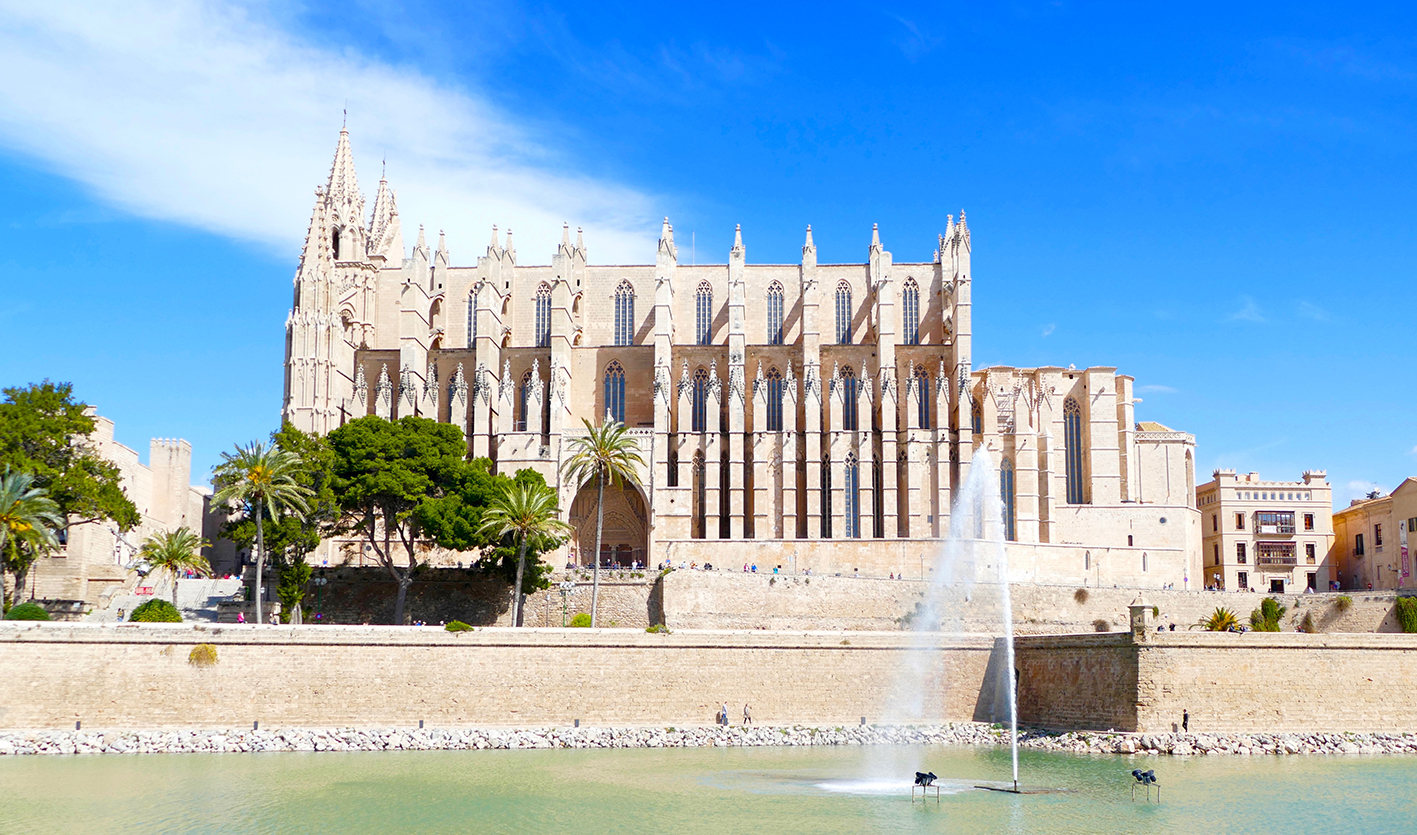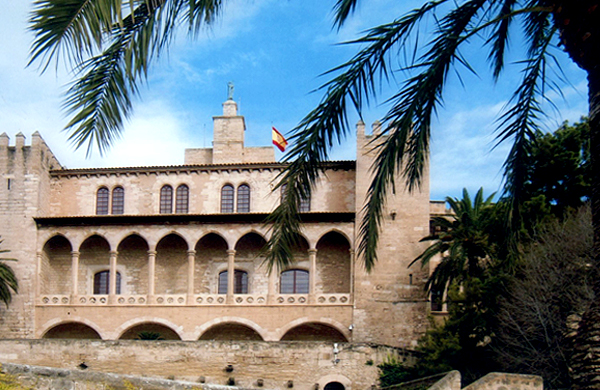Trendy districts in the Mallorcan capital include Monti-Sion and Santa Catalina. The old town remains permanently popular together with Portixol.
Stefanie Claudia Müller, Palma de Mallorca
Tim Wirth has lived in Mallorca for more than 20 years, and his heart has always belonged to to Palma:
“When I first came here everything was still very provincial. Now, however, it is an international business centre and less a tourist hotspot.”
The lawyer, who specializes in real estate, loves to walk through the relatively small and quiet old town after work where you can go from one bar to the other throughout the evening, eat tapas and meet interesting new people.

The cathedral is the symbol of Palma, but Mallorca’s capital has much more to offer.
He recommends, among other places, the restaurant “Casa Gallega” and the bar Flexas in the street of the same name which has a small but very good menu with interesting little things to eat. Wirth also exorts Mallorca fans to come to Palma for Christmas: – “The illuminations are simply very beautiful and the atmosphere is very relaxed”.
Contents
- Passeig des Born is now a luxury shopping zone
- Apartment rent has stabilized at 13.80 euros / sqm
- Rental and purchase prices in Palma are at last year’s level once again
- Mass tourism annoys the inhabitants
- It must be said, however, that Palma offers a little of everything
- Palma’s film festival enters its 3rd year
- Portixol rocks, but so do the rental prices
- Santa Catalina is the most colourful district of Palma
- That which is good is seldom cheap: This applies also to Cort and Monti-Sion
- The perennial old town
- Palma has become an expensive place
Passeig des Born is now a luxury shopping zone
In the old quarter, for example, where countless Mallorcans and residents are out and about.
“And no cars – that’s a good thing. Apart from that in certain places in Palma you forget that you are on a holiday island”

At Christmas time the Passeig Born is festively decorated and illuminated.
says the man who comes from Lübeck. On the Passeig des Born, where the 50-year-old has his office, the Mallorcan capital is at its liveliest but rents here are also in the luxury sector.
Apartment rent has stabilized at 13.80 euros / sqm
“Where there used to be Zara and Mango shops is now Bulgari and Luis Vitton”
says the German lawyer. For a 3-room apartment there and in the surrounding area long-term rent is at least 1.500 euros a month. One-room apartments can be found after intensive searching from 750 euros. For larger,well-renovated apartments, however,the monthly rent can be as much as 4.000 euros. ·
Rental and purchase prices in Palma are at last year’s level once again
“The square-metre prices are once again back to the pre-crisis levels of 2007, which means they are high,”
says Wirth. Rents, however, have stabilised over the past two years according to official statistics.
“In some districts and streets, however, house owners are clearly speculating with their rent due to the high demand. Local government has countered with drastic restrictions on vacation rentals in the city centre,”
says Wirth.

Old town palaces and patrician houses in Palma are coveted investment projects. Often they are luxury renovated and sold as single apartments again expensive.
Wirth is completely satisfied with the exclusive location of his legal practice, which he found many years ago. Not only is it easy to find for his clients, and his staff are close to an Italian ice cream parlour, a café, shops or a snack for lunch, but Wirth can also watch the traditional Three Kings procession on the evening of 5th January, as well as all the other celebrations, from his balcony. Nowadays the renting of balconies for such occasions has become a real business in Spanish towns, a fact which numerous property owners in Palma have already discovered for themselves.
Mass tourism annoys the inhabitants
From balconies like the one at Wirth’s law office more and more civil protests could be observed during the past year and increasingly these have to do with mass tourism which mainly affects Palma. Annoying the traders and residents are particularly the many cruise ships.
Last year there were 4.3% more than in 2017 and around 844 of these ‘travelling towns’ visited the Balearics last year, most of them in Mallorca. This irritated even tolerant people like Wirth who jogs in the mornings along the harbour together with many other foreign Mallorcan residents:
“Because of the cruise tourism the city becomes literally overrun for a few hours by thousands of cruise guests who do not help the gastronomy as they are all-inclusive tourists and block Palma for hours”.
The Balearic government tried to slow down this type of mass tourism in Palma in 2017 by raising the eco-tax, which now also has to be paid by cruise visitors but up to now this has been a very modest success. The Englishman Paul Jessup is of the opinion that the control of mass tourism will be Spain’s biggest challenge in the coming years:
“The country has to rethink and cleverly redirect the flow,”
says the management consultant who is involved in numerous tourism and environmental projects.

Palma is a popular destination for Mediterranean cruises. In 2018, 844 of these floating giants docked at the harbor.
Closely related to this is the problem of mobility: rental electro-boards, bicycles and scooters on footpaths and streets in Palma are causing chaos, and after various accidents involving pedestrians the local government is attempting to restrict their circulation by introducing new laws.
It must be said, however, that Palma offers a little of everything
Mercedes Korzeniowski is Swiss and would not wish to live in the capital with her family due to the traffic problems during the week. She loves to visit Palma, however, for its wide range of leisure activities particularly at the weekends:
”The town is ideal to enjoy a Saturday with a visit to the theatre, good restaurants and music”.
She loves to go with her daughter not only shopping, but also through the Jewish or Arabic districts.
”Many people are not aware of this aspect of Palma”.
The marketing expert recommends a stroll through the streets of Palau Reial, Victoria, Santo Domingo and Costa de la Seu where many archaeological sights can be found:
“But the Palma cathedral is also definitely worth a visit”,
says the 49 year-old who has chosen to live in Mallorca.
Wirth also recommends the cathedral of Santa Maria, even to those who are not normally church-goers:
”Particularly at Christmas time it is very musical here”.
The Christmas mass is held in German and songs from all over the world are sung. This year the soprano Waltraud Mucher, the trumpeter Jose Miguel Asensi and the organist Klaus Sehling brought the Christmas feeling to the congregation and Carson Cooman, an organist from Harvard university in the USA also joined in.
Thanks to the 13th century cathedral Mallorca’s capital is far more than just a shopping location for tourists during bad weather.
Palma’s film festival enters its 3rd year
Nowadays not only wealthy people from Hamburg and Munich can be found strolling through the alleys around the imposing building – called simply ‘La Seu’ (the seat of the bishop) – but also artists from all over the world, both in summer and winter.

By day, Palma’s cathedral is already impressive, but at night, brightly lit, its sight is just too overwhelming.
Sandra Seeling Lipski is one of them. She is a German actress born in Berlin but who grew up in Mallorca. Seeling Lipski commutes now between the island and L.A. where she is married. The actress is the organiser of the Evolution! Mallorca International Film Festival (EMIFF) which for a few years has taken place in Palma once a year in autumn.
”Between the opera, top-hotels and other locations we organise an event which now attracts world-class artists”,
she proudly announces.
This year the festival takes place for the 8th time from the 24th to the 30th October. With her festival Seeling Lipski profits not only from the enormous international attractiveness of the island but also from the money which is located there. She can only finance her film festival through sponsors, and wealth abounds in Mallorca.
Actors and producers come not only because of the film festival, but also because Palma has become a networking centre. Districts like Portixol are very popular with festival-visitors, and rents for small apartments with beach locations have already risen to over 2.000 euros per month. With holiday rentals an overnight stay in a 2-room apartment can cost from 200 euros.
Portixol rocks, but so do the rental prices
The former fisherman’s district Portixol, which still possesses its village structure, has gained enormous momentum over the past years. Here there are small creative hotels and cool beach bars, but also long stretches along the sea for skating, cycling and jogging.

The former fishing district Portixol is now one of the best addresses of Palma.
Although quite close to the tourist hustle-and-bustle of Playa de Palma and Arenal mass-tourism is hardly noticeable. The houses are small and attractive, but those seeking a property here will not find it easy – on the first beach line there is hardly anything for sale, and what can be found will certainly not be priced at under a million euros. Further back the district is, of course, cheaper but not so desirable.
Santa Catalina is the most colourful district of Palma
Those who are looking for somewhere more colourful and livelier than Portixol are in the right place in Santa Catalina. Here there are objects available for under a million euros, due to the fact that this used to be a traditional workers district with many immigrants.
All around the weekly market life is still relatively cheap, but everything that gets closer to the sea is once again a half a million euros up to prices of 2.5 million.
”Those who are looking for authenticity and a multi-cultural atmosphere are in the right place here”,
says Wirth. The ‘Mercat de Santa Catalina’, specialising in tapas, is the pulsating heart of this immigrant quarter and surrounded by countless cafes, bars and extravagant deco-shops. Normally Mallorcans go to the market at around 13.00, and drink a convivial glass of cava, a vermouth or a glass of the ever-popular local white wine. These are served accompanied by tapas and afterwards those who want can go to the local afternoon disco, slightly tipsy. Those who do not want to drink and eat while standing, but prefer to sit comfortably, can try the nearby international in-restaurant ‘Duke’, which advertises the fact that it has no specific style but is simply a mix of many themes.
That which is good is seldom cheap: This applies also to Cort and Monti-Sion
Those seeking a property in the trendy areas of Cort around the Placa Cort, or Monti-Sion in the centre of Palma should be ready to put large sums on the table – although up to now not too many tourists can be found in these areas as there are not too many bars and restaurants. House prices, depending on location and with or without sea views, can go as high as 13 million euros.
If you go from the Placa Cort around the old town hall, across the Placa Santa Eulalia and to the east of Palma you will reach the Monti-Sion district with its lively art scene, enchanting courtyards and tranquillity.

Worthwhile sidelong: behind the simple stone facades in Palma’s old town often hide magical courtyards
The harbour is right opposite so that some apartments offer views of the sea. To rent a penthouse apartment for the holiday season here above the roofs of Palma you will need to pay between 100 and 350 euros per day, starting in May. The renovation of the old apartments, however, was carried out in the most part with such attention to detail that they have very little in common with standard Airbnb apartments which are often notorious in Palma and are nowadays hardly on offer.
The perennial old town
Those who are drawn to the old quarter of Palma, either as house-owner or tourist, are naturally surrounded by bars but also by rubbish and noise at the weekends. The narrow alleyways are not passable by car and there are no parking possibilities on the streets, and it is even very difficult to navigate anywhere by bicycle.
Netty Karabuth loves it in spite of all that. She has lived in Mallorca for a long time and recommends a visit to the ‘Mercado de San Juan’, a gastronomic weekly market in the old slaughterhouse ‘S’Escorxador’ in the heart of the town. Like in Madrid this was planned to become a culture centre – ”that did not really work”, Wirth reveals. Instead, however, good authors’ films are presented in its old halls.
Kalabuth loves the bustle in the old slaughterhouse –
”every day from 12 :00 in the morning until midnight there is action, at the weekends until 04:00 in the morning”.
For the 45 year-old Palma’s beach promenade is also very attractive as a place to live and go out, and here one of her favourite discos can be found – Titos.

It is so quiet on the Paseo Maritimo only in the early morning hours.
Opposite the hundreds of yachts from all over the world and the occasional cruise ship is also the world-renowned Capuccino cafe, which also has branches in various parts of Palma and Mallorca, including on the Passeig des Born. Here the service is first class, as are the prices.
Palma has become an expensive place
Palma is definitely no longer cheap, particularly to live permanently. There are, however, still bargains to be found even in the old town where a lot of properties still need renovation. Taking into account the enormous housing shortage for people who work in Palma it can be expected that rents will rise rather than fall. Real estate lawyer Wirth, however, warns owners:
”Those who rent to locals and not to tourists should be aware that many will not be able to afford the rental prices in the future with their current salaries. You should not speculate with long-term tenants”.

